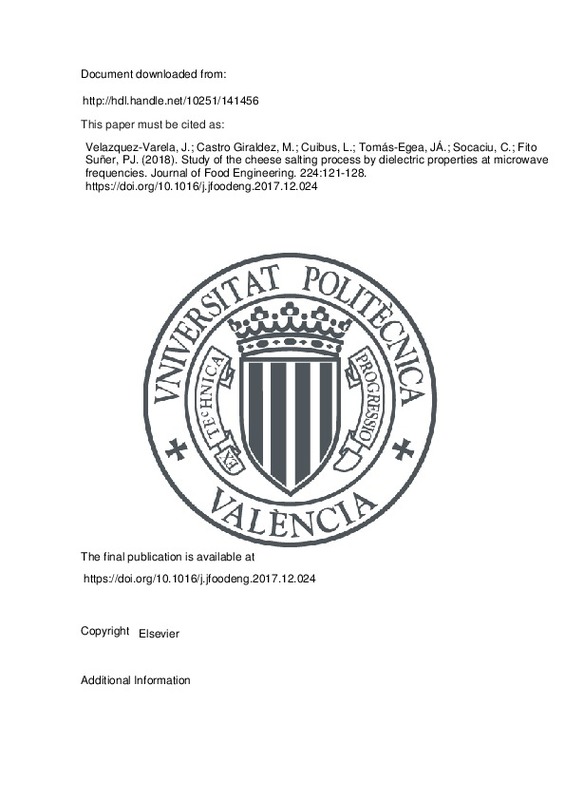JavaScript is disabled for your browser. Some features of this site may not work without it.
Buscar en RiuNet
Listar
Mi cuenta
Estadísticas
Ayuda RiuNet
Admin. UPV
Study of the cheese salting process by dielectric properties at microwave frequencies
Mostrar el registro sencillo del ítem
Ficheros en el ítem
| dc.contributor.author | Velazquez-Varela, Jose
|
es_ES |
| dc.contributor.author | Castro Giraldez, Marta
|
es_ES |
| dc.contributor.author | Cuibus, Lucian
|
es_ES |
| dc.contributor.author | Tomás-Egea, Juan Ángel
|
es_ES |
| dc.contributor.author | Socaciu, C.
|
es_ES |
| dc.contributor.author | Fito Suñer, Pedro José
|
es_ES |
| dc.date.accessioned | 2020-04-24T07:14:14Z | |
| dc.date.available | 2020-04-24T07:14:14Z | |
| dc.date.issued | 2018 | es_ES |
| dc.identifier.issn | 0260-8774 | es_ES |
| dc.identifier.uri | http://hdl.handle.net/10251/141456 | |
| dc.description.abstract | [EN] The salting process involves complex phenomena that affect the overall quality of cheese due to its effect on water activity and induced biochemical changes. The permittivity of cheese was analysed throughout the cheese salting treatment in order to relate it to water and salt transport. The salting treatment was carried out using 25% (wily) sodium chloride brine at 4 degrees C. The samples were immersed in a vessel containing the osmotic solution with continuous stirring, for 0, 10, 20, 30, 40, 50, 60, 90, 120, 180, 240, 360, 480, 720, 900 and 1440 min. Samples were subsequently equilibrated in an isothermal chamber at 4 degrees C for 24 h. Mass, volume, surface water activity, moisture, ion content and permittivity were determined in fresh and salted samples. Permittivity was measured from 500 MHz to 20 GHz, using an openended coaxial probe connected to a Vector Network Analyser. The results showed that measurements at 20 GHz explain the water loss and water flux in the overall product. The state of the electrolytes in cheese can be followed using the ionic conductivity at 500 MHz. A coupled measurement of permittivity at 20 GHz and 500 MHz can predict the chemical species involved in the cheese salting process, and its structural changes. In conclusion, the measurement of permittivity in the microwave range can be used to monitor the salting cheese process. (C) 2018 Elsevier Ltd. All rights reserved. | es_ES |
| dc.description.sponsorship | The authors acknowledge financial support from the Spanish Ministerio de Economia, Industria y Competitividad, Programa Estatal de I+D+i orientada a los Retos de la Sociedad AGL2016-80643-R. Author J. Velazquez-Varela thanks the Consejo Nacional de Ciencia y Tecnologia (CONACyT) of Mexico for its support. This paper was published under the frame of the European Social Fund, Human Resources Development Operational Programme 2007-2013, project no. POSDRU/159/1.5/S/132765. | es_ES |
| dc.language | Inglés | es_ES |
| dc.publisher | Elsevier | es_ES |
| dc.relation.ispartof | Journal of Food Engineering | es_ES |
| dc.rights | Reconocimiento - No comercial - Sin obra derivada (by-nc-nd) | es_ES |
| dc.subject | Cheese | es_ES |
| dc.subject | Brining | es_ES |
| dc.subject | Permittivity | es_ES |
| dc.subject | Sodium chloride | es_ES |
| dc.subject.classification | TECNOLOGIA DE ALIMENTOS | es_ES |
| dc.title | Study of the cheese salting process by dielectric properties at microwave frequencies | es_ES |
| dc.type | Artículo | es_ES |
| dc.identifier.doi | 10.1016/j.jfoodeng.2017.12.024 | es_ES |
| dc.relation.projectID | info:eu-repo/grantAgreement/ESF//POSDRU%2F159%2F1.5%2FS%2F132765/ | es_ES |
| dc.relation.projectID | info:eu-repo/grantAgreement/MINECO//AGL2016-80643-R/ES/UTILIZACION DE LAS PROPIEDADES DIELECTRICAS EN EL CONTROL DE LA CALIDAD Y DE LA SEGURIDAD DE LA CARNE DE AVE/ | es_ES |
| dc.rights.accessRights | Abierto | es_ES |
| dc.contributor.affiliation | Universitat Politècnica de València. Departamento de Tecnología de Alimentos - Departament de Tecnologia d'Aliments | es_ES |
| dc.contributor.affiliation | Universitat Politècnica de València. Instituto Universitario de Ingeniería de Alimentos para el Desarrollo - Institut Universitari d'Enginyeria d'Aliments per al Desenvolupament | es_ES |
| dc.description.bibliographicCitation | Velazquez-Varela, J.; Castro Giraldez, M.; Cuibus, L.; Tomás-Egea, JÁ.; Socaciu, C.; Fito Suñer, PJ. (2018). Study of the cheese salting process by dielectric properties at microwave frequencies. Journal of Food Engineering. 224:121-128. https://doi.org/10.1016/j.jfoodeng.2017.12.024 | es_ES |
| dc.description.accrualMethod | S | es_ES |
| dc.relation.publisherversion | https://doi.org/10.1016/j.jfoodeng.2017.12.024 | es_ES |
| dc.description.upvformatpinicio | 121 | es_ES |
| dc.description.upvformatpfin | 128 | es_ES |
| dc.type.version | info:eu-repo/semantics/publishedVersion | es_ES |
| dc.description.volume | 224 | es_ES |
| dc.relation.pasarela | S\350193 | es_ES |
| dc.contributor.funder | European Social Fund | es_ES |
| dc.contributor.funder | Consejo Nacional de Ciencia y Tecnología, México | es_ES |
| dc.contributor.funder | Ministerio de Economía y Competitividad | es_ES |







![[Cerrado]](/themes/UPV/images/candado.png)

